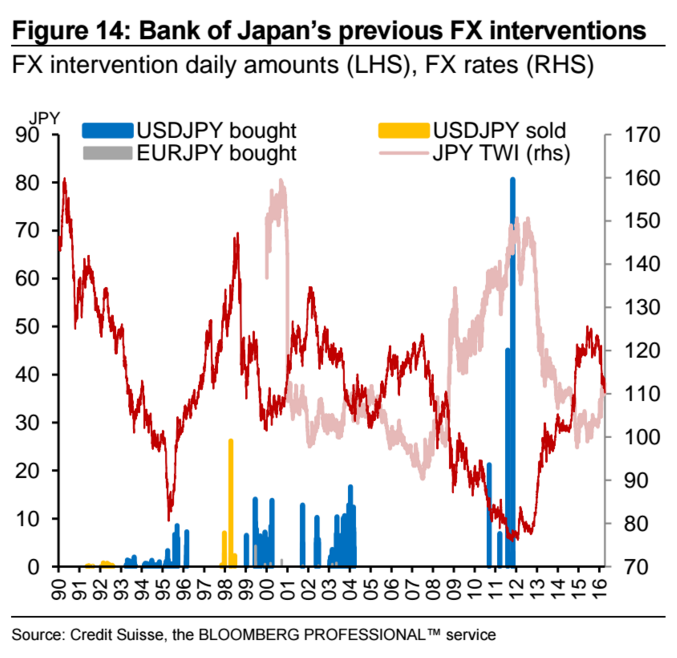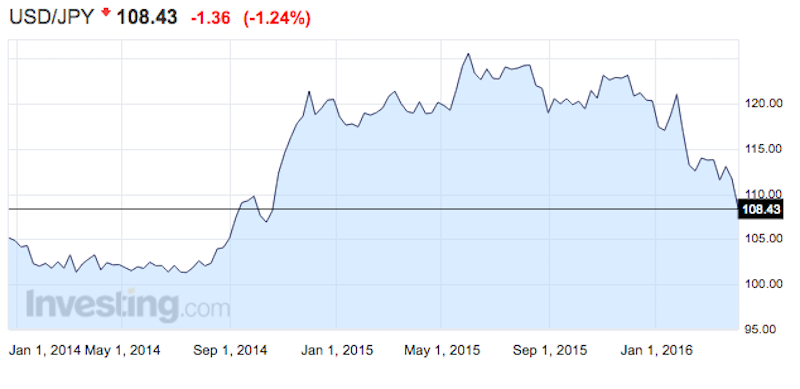The Japanese yen is on fire.

That’s the strongest level since October 19, 2014 — right before the Bank of Japan shocked the markets by boosting its quantitative-easing program.
The yen is now up about 10% vs. the dollar in 2016.
Thursday’s surge followed comments from the Bank of Japan’s (BoJ) governor, Haruhiko Kuroda, who suggested that the central bank could ease policy even further if needed.
Generally speaking, a weaker currency helps Japan’s exporters and corporate profits. So, some economists argue that a surging yen is bad for business.
Moreover, Chief Cabinet Secretary Yoshihide Suga said later on Thursday that “We’re watching the foreign exchange market with a sense of tension,” adding that “the government believes excessive and disorderly movements in the exchange rate have a negative effect.”

Despite all of that, analysts don’t think the BoJ will intervene this time around given the imminent G7 meeting next month.
“With Japan hosting the next key G7 meeting on 26-27 May, we doubt that politically challenging intervention is likely at this stage, especially if USDJPY’s decline is slow and steady and the Nikkei avoids a disastrous meltdown,” a Credit Suisse research team led byShahab Jalinoos argued in a note on April 6.
“The summit is the focal point of Prime Minister Shinzo Abe’s diplomatic strategy for the year and intervention to weaken the yen would destroy any chance he has of G7 leadership,” explained the Financial Times’ Robin Harding and Claire Jones.
For what it’s worth, Abe told The Wall Street Journal on Tuesday that countries should avoid competitively devaluing their currencies.
As an end note, the Credit Suisse team also cited other tricky political concerns.
“We suspect at a sensitive time ahead of the US presidential election in November, and with the recently agreed Trans Pacific Partnership (TPP) deal still far from being passed by Congress, Japan will not want to risk becoming a candidate for official inclusion in the US Treasury’s FX manipulation report,” they wrote.
“Indeed, aside from brief periods in the post-2008 period, the type of ‘line in the sand’ strategy that was employed in the early 2000s has not been a feature of Japanese currency policy in recent years,” they added.
The yen is stronger by 1.2% at 108.43 against the dollar as of 3:49 p.m. EST.



 Hayao Miyazaki says Happy New Year to Studio Ghibli fans with new art for Year of the Horse
Hayao Miyazaki says Happy New Year to Studio Ghibli fans with new art for Year of the Horse We revisited Sweets Paradise after a decade to see if Japan’s dessert buffet still delivers
We revisited Sweets Paradise after a decade to see if Japan’s dessert buffet still delivers Japanese company selling bear-proof automatic doors
Japanese company selling bear-proof automatic doors Japanese-style accommodation at the new Premium Dormy Inn hotel in Asakusa will blow your mind
Japanese-style accommodation at the new Premium Dormy Inn hotel in Asakusa will blow your mind Is this the most relaxing Starbucks in Japan?
Is this the most relaxing Starbucks in Japan? Hayao Miyazaki says Happy New Year to Studio Ghibli fans with new art for Year of the Horse
Hayao Miyazaki says Happy New Year to Studio Ghibli fans with new art for Year of the Horse We revisited Sweets Paradise after a decade to see if Japan’s dessert buffet still delivers
We revisited Sweets Paradise after a decade to see if Japan’s dessert buffet still delivers Japanese company selling bear-proof automatic doors
Japanese company selling bear-proof automatic doors Japanese-style accommodation at the new Premium Dormy Inn hotel in Asakusa will blow your mind
Japanese-style accommodation at the new Premium Dormy Inn hotel in Asakusa will blow your mind Is this the most relaxing Starbucks in Japan?
Is this the most relaxing Starbucks in Japan? Super Mario and Baskin-Robbins release a power-up ice cream collection in Japan
Super Mario and Baskin-Robbins release a power-up ice cream collection in Japan That time Seiji called JASRAC to ask why he didn’t get paid royalties for his song being on TV
That time Seiji called JASRAC to ask why he didn’t get paid royalties for his song being on TV Are all Starbucks coffee sizes the same? Testing the viral video claim in Japan
Are all Starbucks coffee sizes the same? Testing the viral video claim in Japan McDonald’s releases new “Yakki” burger based on a popular Japanese meal
McDonald’s releases new “Yakki” burger based on a popular Japanese meal Godzilla-shaped ice cream on sale in Tokyo near the sight his most adorable rampage
Godzilla-shaped ice cream on sale in Tokyo near the sight his most adorable rampage Starbucks Japan ready to get Year of the Horse started with adorable drinkware and plushies【Pics】
Starbucks Japan ready to get Year of the Horse started with adorable drinkware and plushies【Pics】 Cyberpunk anime meets traditional culture in Ghost in the Shell gold leaf Japanese changing screens
Cyberpunk anime meets traditional culture in Ghost in the Shell gold leaf Japanese changing screens 7 great places to see Mt. Fuji from without having to climb it
7 great places to see Mt. Fuji from without having to climb it Hello Kitty Choco Egg figures are an adorable trip through three periods of Japanese pop culture【Pics】
Hello Kitty Choco Egg figures are an adorable trip through three periods of Japanese pop culture【Pics】 7-Eleven Japan’s ramen-cooking robot whipped us up a bowl of noodles【Taste test】
7-Eleven Japan’s ramen-cooking robot whipped us up a bowl of noodles【Taste test】 We found possibly the quietest Japanese-style hotel in Tokyo’s bustling Shinjuku district
We found possibly the quietest Japanese-style hotel in Tokyo’s bustling Shinjuku district Japan’s otoshidama tradition of giving kids money at New Year’s gets a social welfare upgrade
Japan’s otoshidama tradition of giving kids money at New Year’s gets a social welfare upgrade Sumo Sanrio! Hello Kitty and pals team up with Japan Sumo Association for new merch【Pics】
Sumo Sanrio! Hello Kitty and pals team up with Japan Sumo Association for new merch【Pics】 More Than a Capsule Stay: Why Solo Travelers Choose “global cabin Yokohama Chinatown”
More Than a Capsule Stay: Why Solo Travelers Choose “global cabin Yokohama Chinatown” Japan’s oldest largetooth sawfish in captivity back on display in Mie Prefecture
Japan’s oldest largetooth sawfish in captivity back on display in Mie Prefecture 7-Eleven Japan starts new temporary luggage storage service in over 300 branches
7-Eleven Japan starts new temporary luggage storage service in over 300 branches Disillusionment at Tsukiji’s tourist-target prices led us to a great ramen restaurant in Tokyo
Disillusionment at Tsukiji’s tourist-target prices led us to a great ramen restaurant in Tokyo Starbucks teams up with 166-year-old Kyoto doll maker for Year of the Horse decorations【Photos】
Starbucks teams up with 166-year-old Kyoto doll maker for Year of the Horse decorations【Photos】 Tokyo considering law requiring more trash cans following litter increase in heavily touristed area
Tokyo considering law requiring more trash cans following litter increase in heavily touristed area Tokyo’s Tsukiji sushi neighborhood asks tour groups to stay away for the rest of the month
Tokyo’s Tsukiji sushi neighborhood asks tour groups to stay away for the rest of the month Tokyo event lets you travel back in time, for free, to celebrate 100 years since Showa era start
Tokyo event lets you travel back in time, for free, to celebrate 100 years since Showa era start Sanrio theme park in Japan announces plans to expand into a Sanrio resort
Sanrio theme park in Japan announces plans to expand into a Sanrio resort Japan may add Japanese language proficiency, lifestyle classes to permanent foreign resident requirements
Japan may add Japanese language proficiency, lifestyle classes to permanent foreign resident requirements Stamina-destroying “Paralysis Noodles” are Tokyo’s newest over-the-top ramen innovation
Stamina-destroying “Paralysis Noodles” are Tokyo’s newest over-the-top ramen innovation Survey asks foreign tourists what bothered them in Japan, more than half gave same answer
Survey asks foreign tourists what bothered them in Japan, more than half gave same answer Japan’s human washing machines will go on sale to general public, demos to be held in Tokyo
Japan’s human washing machines will go on sale to general public, demos to be held in Tokyo Japan’s deadliest food claims more victims, but why do people keep eating it for New Year’s?
Japan’s deadliest food claims more victims, but why do people keep eating it for New Year’s? We deeply regret going into this tunnel on our walk in the mountains of Japan
We deeply regret going into this tunnel on our walk in the mountains of Japan Studio Ghibli releases Kodama forest spirits from Princess Mononoke to light up your home
Studio Ghibli releases Kodama forest spirits from Princess Mononoke to light up your home Major Japanese hotel chain says reservations via overseas booking sites may not be valid
Major Japanese hotel chain says reservations via overseas booking sites may not be valid Put sesame oil in your coffee? Japanese maker says it’s the best way to start your day【Taste test】
Put sesame oil in your coffee? Japanese maker says it’s the best way to start your day【Taste test】 No more using real katana for tourism activities, Japan’s National Police Agency says
No more using real katana for tourism activities, Japan’s National Police Agency says Starbucks Japan reveals new sakura drinkware collection, inspired by evening cherry blossoms
Starbucks Japan reveals new sakura drinkware collection, inspired by evening cherry blossoms Updated cherry blossom forecast shows extra-long sakura season for Japan this year
Updated cherry blossom forecast shows extra-long sakura season for Japan this year Super Mario and Baskin-Robbins release a power-up ice cream collection in Japan
Super Mario and Baskin-Robbins release a power-up ice cream collection in Japan That time Seiji called JASRAC to ask why he didn’t get paid royalties for his song being on TV
That time Seiji called JASRAC to ask why he didn’t get paid royalties for his song being on TV Are all Starbucks coffee sizes the same? Testing the viral video claim in Japan
Are all Starbucks coffee sizes the same? Testing the viral video claim in Japan McDonald’s releases new “Yakki” burger based on a popular Japanese meal
McDonald’s releases new “Yakki” burger based on a popular Japanese meal Godzilla-shaped ice cream on sale in Tokyo near the sight his most adorable rampage
Godzilla-shaped ice cream on sale in Tokyo near the sight his most adorable rampage Cup Noodle releases new Tomica “car” collection
Cup Noodle releases new Tomica “car” collection Thousands of anime fans gather for public screenings of new Dragon Ball episode in Latin America
Thousands of anime fans gather for public screenings of new Dragon Ball episode in Latin America Japanese police are not messing around, with Patlabor robot mecha out on display 【Video】
Japanese police are not messing around, with Patlabor robot mecha out on display 【Video】 Japanese group to hold fashion show of colostomy bags and other stoma equipment in Paris
Japanese group to hold fashion show of colostomy bags and other stoma equipment in Paris 7-Eleven Japan’s ramen-cooking robot whipped us up a bowl of noodles【Taste test】
7-Eleven Japan’s ramen-cooking robot whipped us up a bowl of noodles【Taste test】 New Evangelion short anime, written by Hideaki Anno, to have world premiere early next year
New Evangelion short anime, written by Hideaki Anno, to have world premiere early next year
Leave a Reply